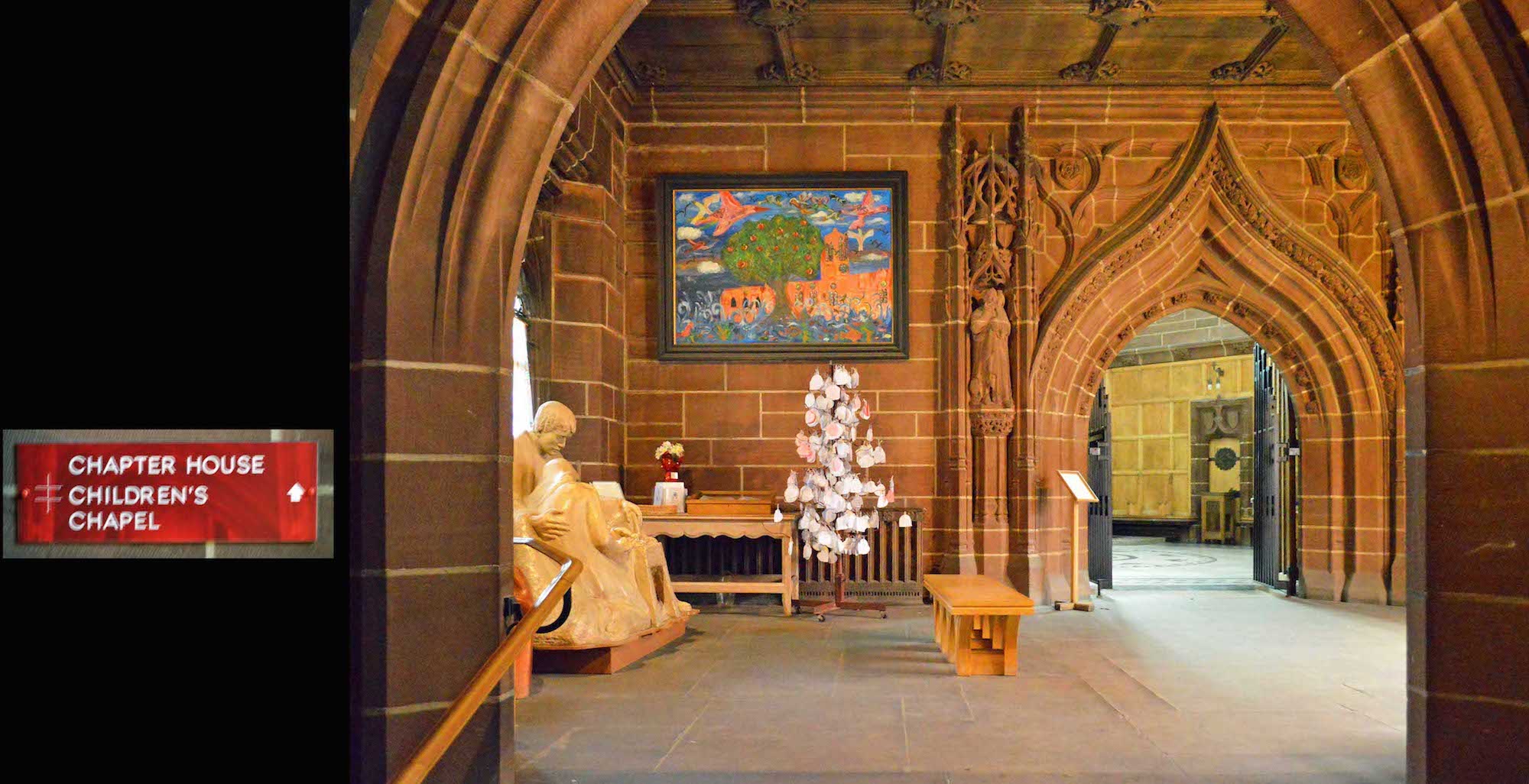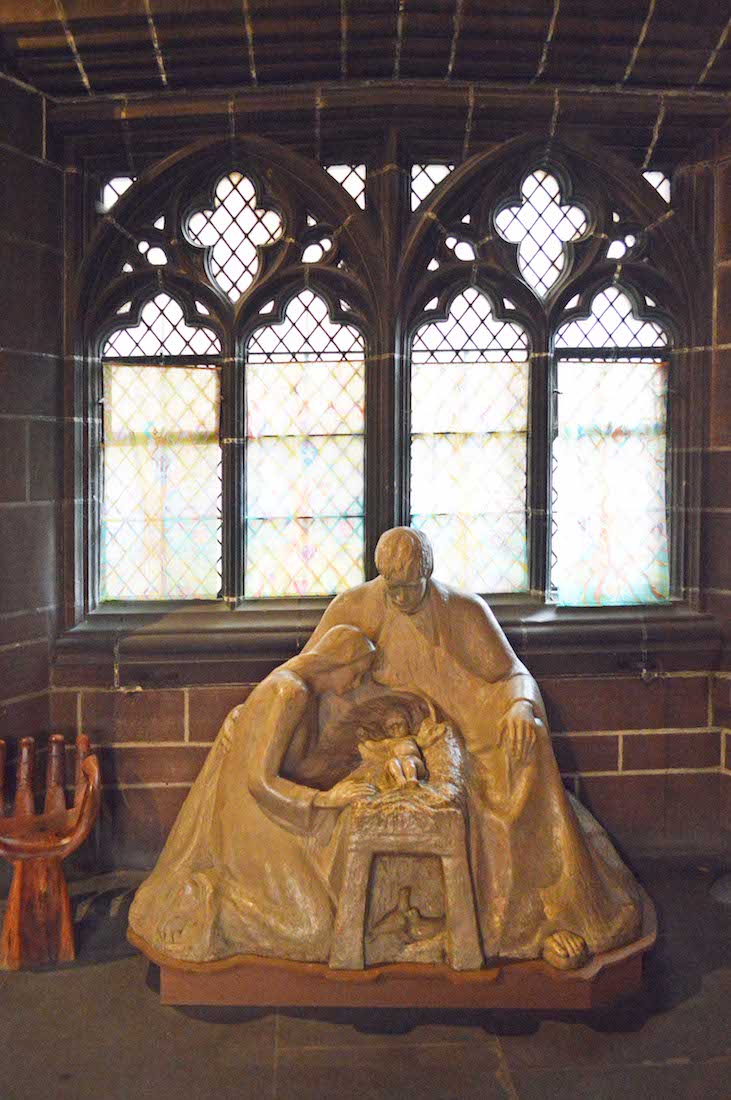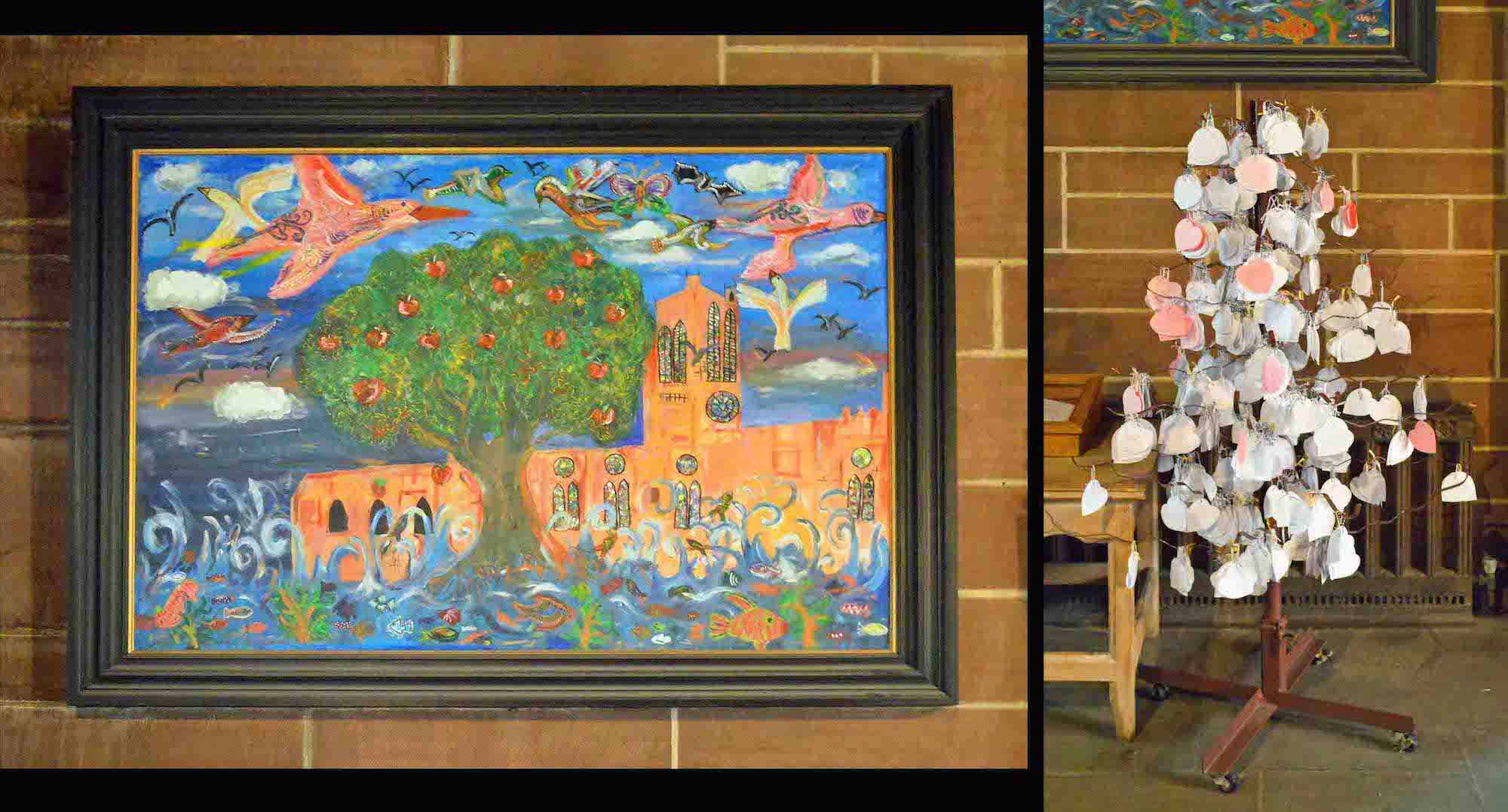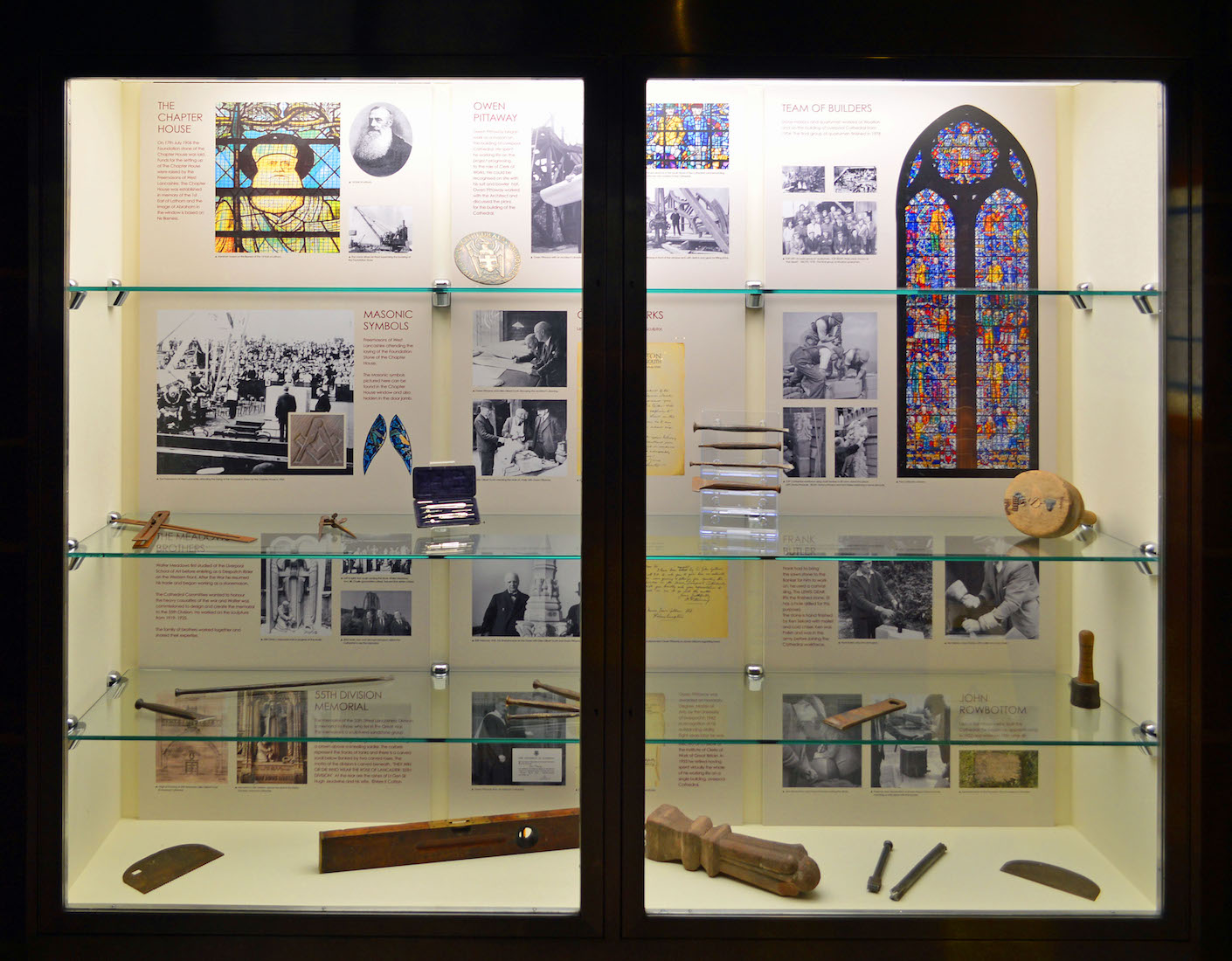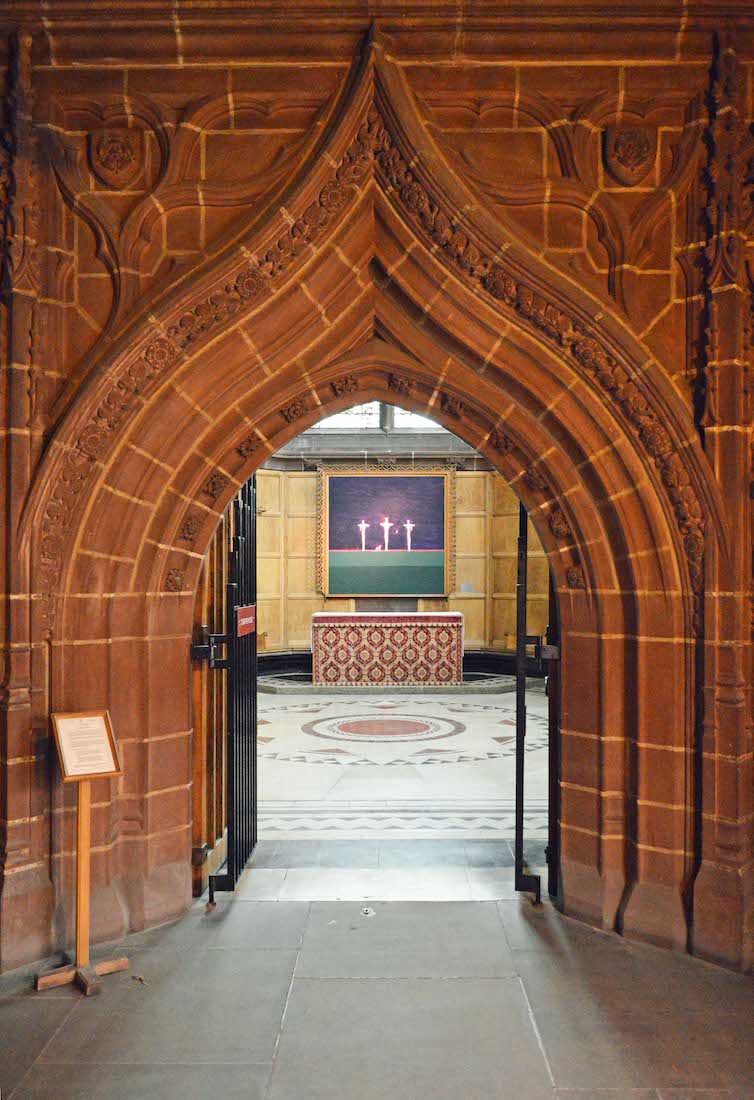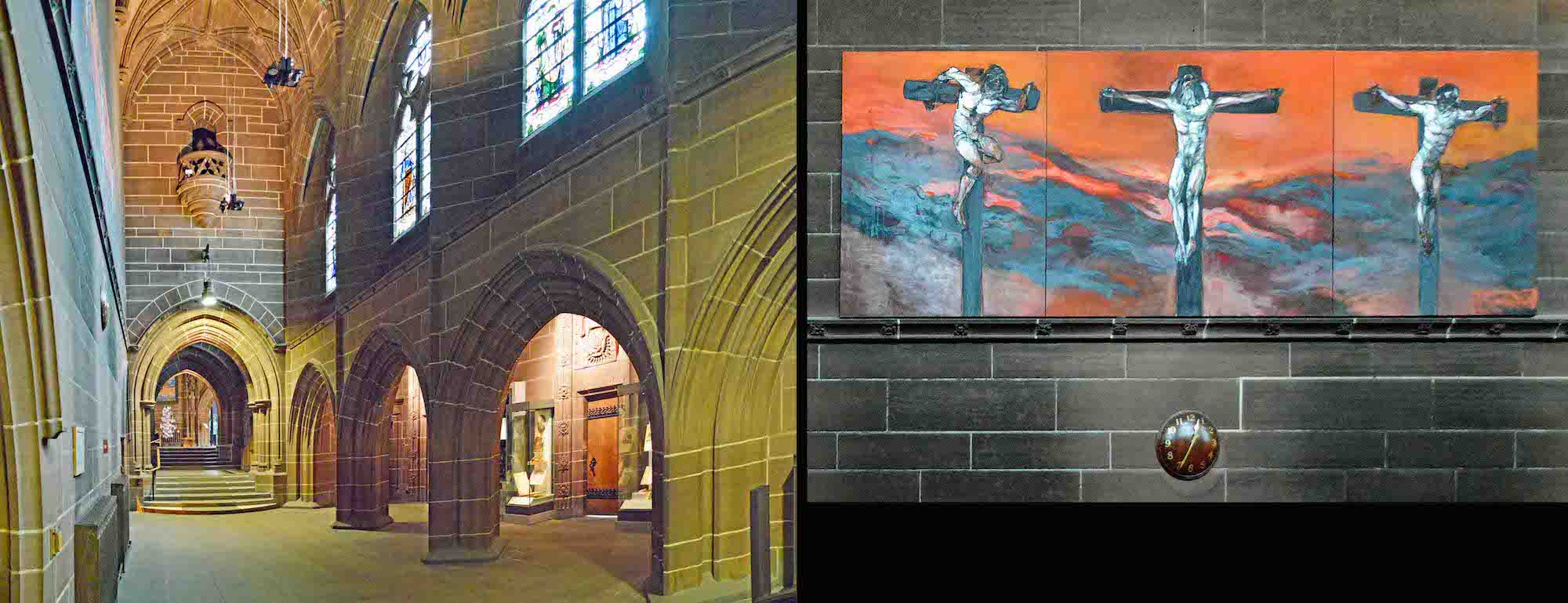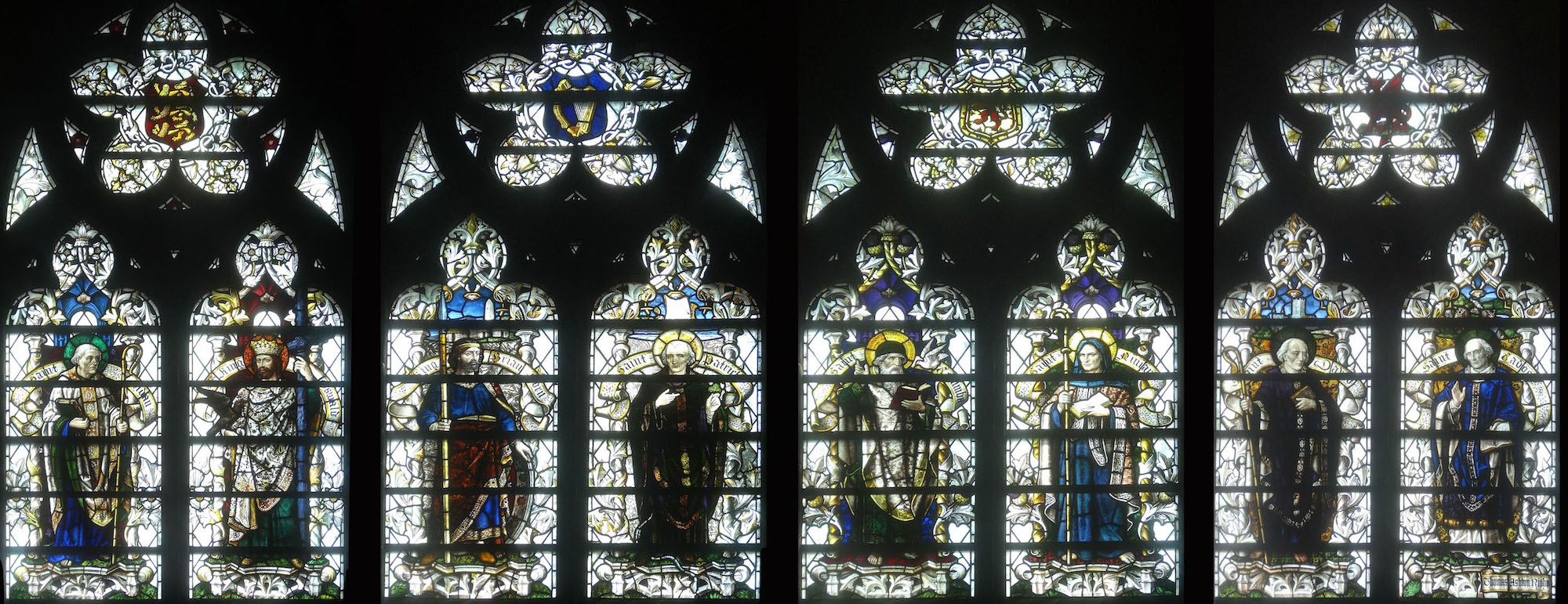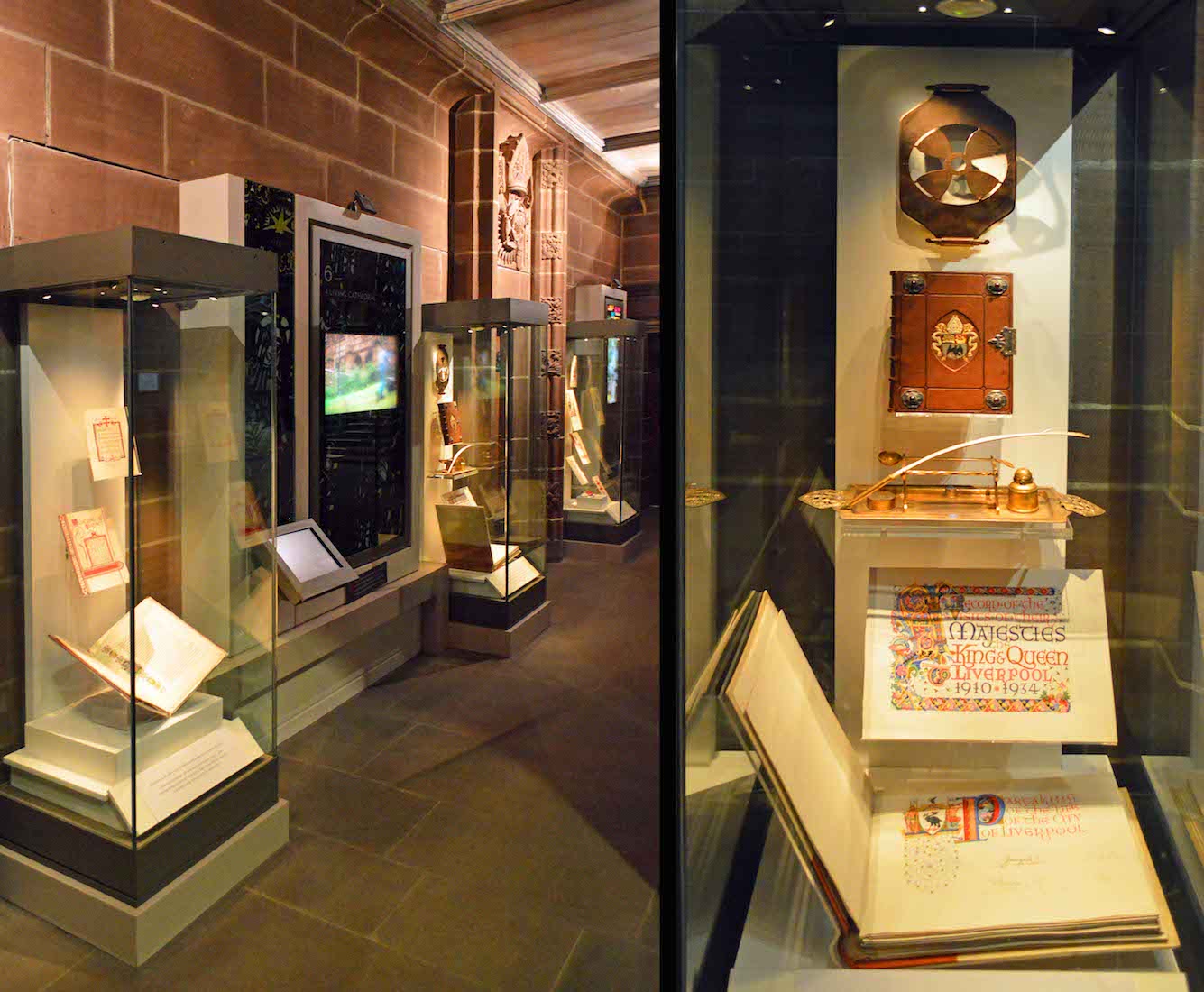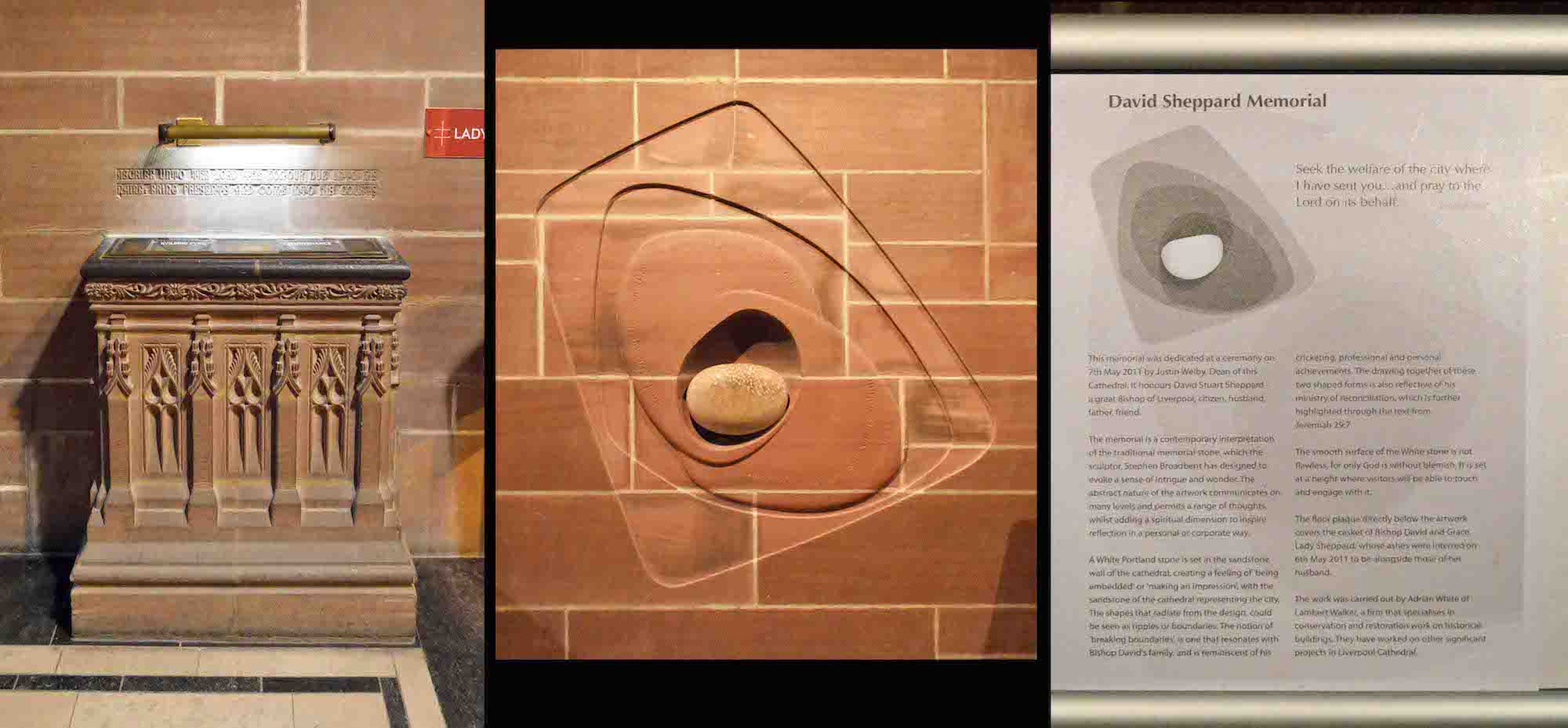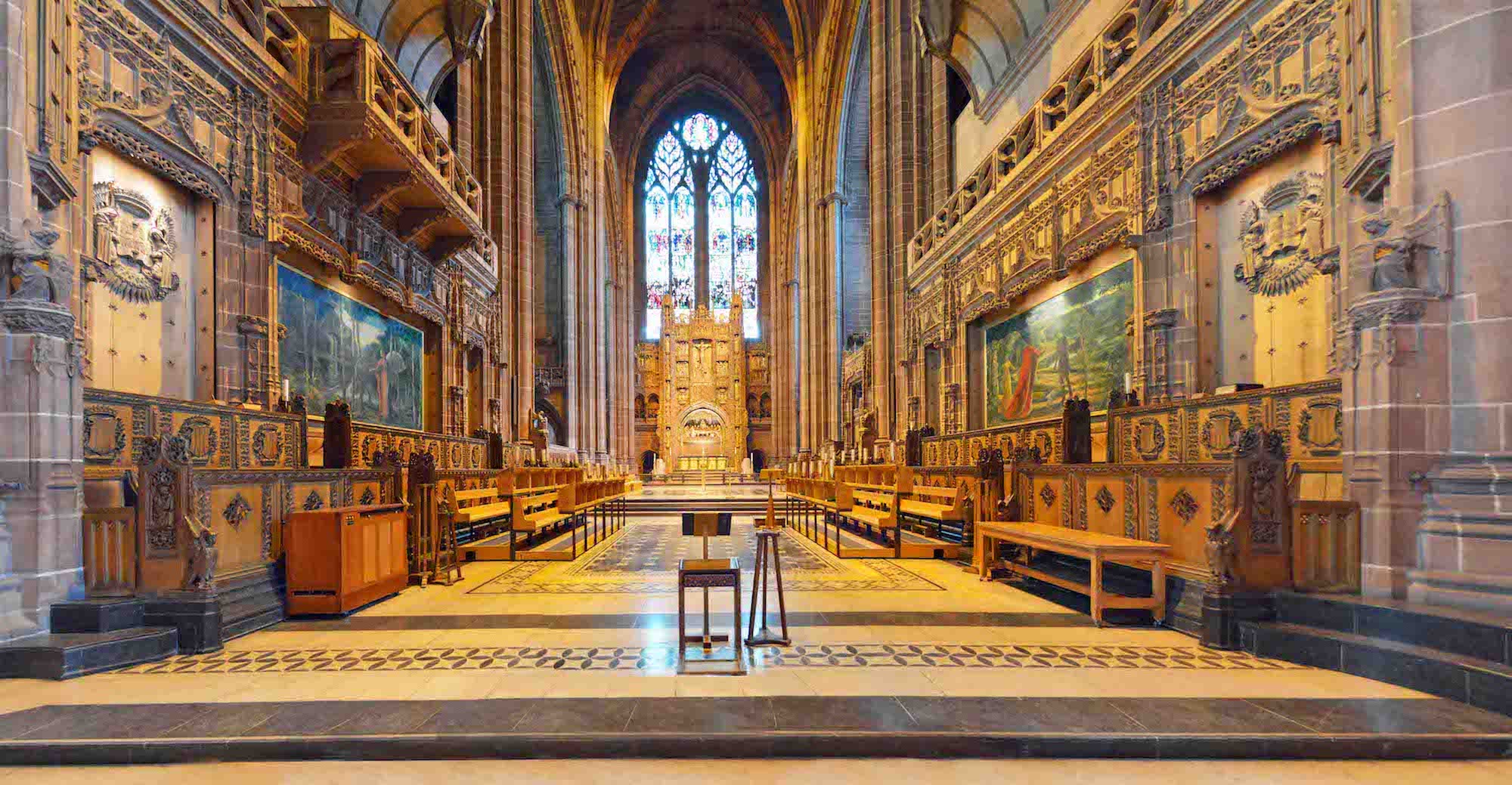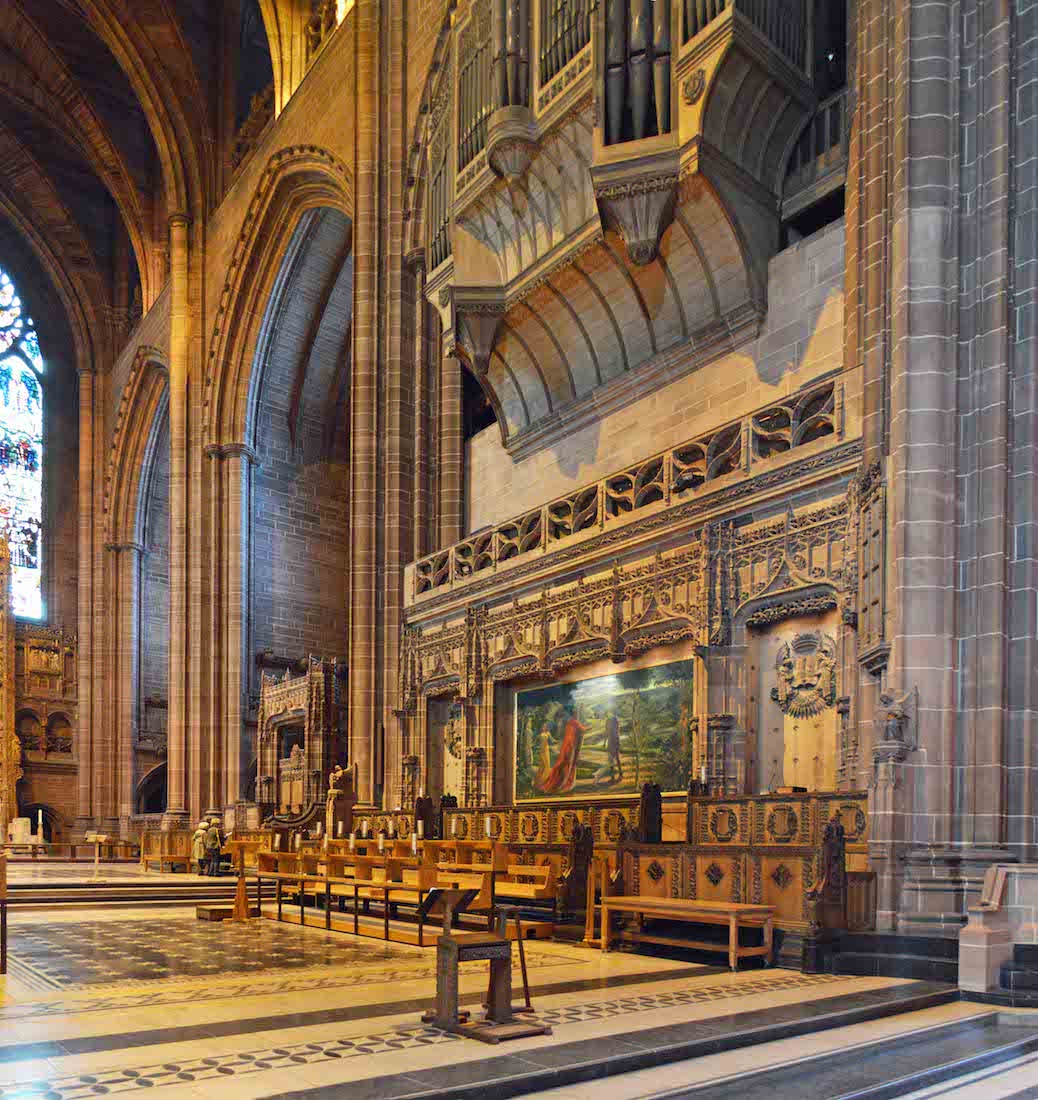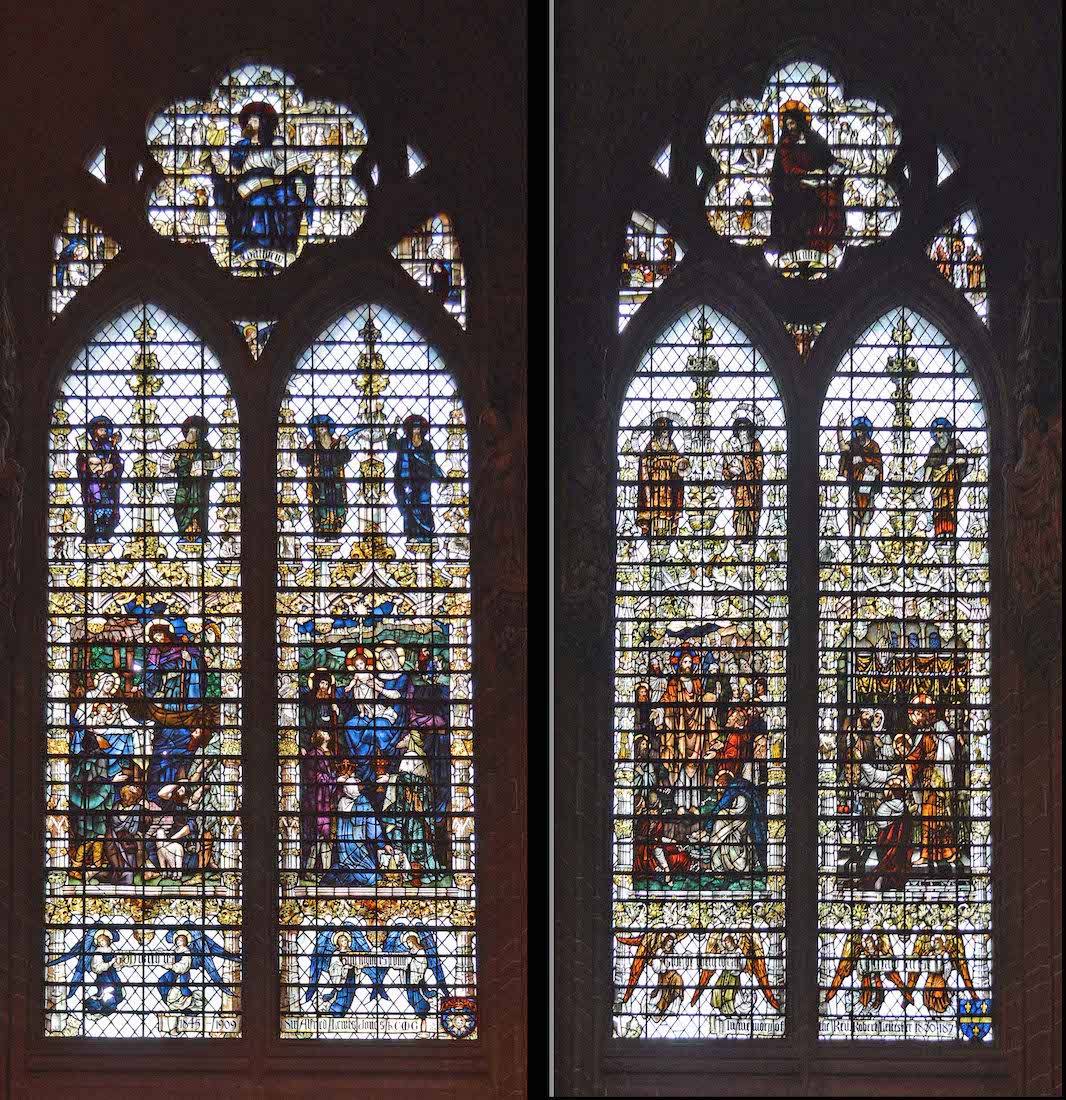
These windows by Brown (and two in the South ambulatory), each known by its predominant colour, show the author of a gospel at the top with his symbol. Below are figures linked with the subject matter of the gospel. The Sapphire window at left represents Saint Matthew and shows a depiction of the Nativity on one side, and the Epiphany on the other. The 'Gold' window at right commemorates Saint Luke and shows the Feeding of the Five thousand, and the Raising of Jairus' daughter. PLAN
62. NORTH EAST AMBULATORY ROSE WINDOW

At the end of the North ambulatory is a rose window by Brown. This window relates to ‘journeys across the sea and undertaken in faith’, namely Moses crossing the Red Sea, Saint Paul’s journey to Rome, Saint Columba planting a cross on Iona, and missionaries of the Melanesian Mission landing in the Solomon Islands.
63. CHILDREN’S CHAPEL
In 2006, the then Bishop of Warrington, the Right Reverend David Jennings, commissioned this area between the ambulatory and the chapter house, to be the Children’s Chapel during a special service of thanksgiving and prayers. Jesus drew children close to Him because he loved and valued them. In the same way, the Cathedral, through the work of the Education Centre and this designated area, proclaims a commitment to children and families, future generations and individuals in need of comfort.
64. THE HOLY FAMILY SCULPTURE
Currently in the Children’s Chapel is this sculpture, ‘Holy Family’ by Josefina de Vasconcellos, who was the daughter of a Brazilian diplomat. Vasconcellos continued working well into her nineties, and in 2001, as the world’s oldest sculptor, was commissioned by Sir Richard Branson to do a new work for Coventry Cathedral. She died in 2005, aged 100. The sculpture may be found elsewhere in the Cathedral at various times.
65. PAINTING AND PRAYER TREE
Also in this chapel is this painting and a little ‘prayer tree’. The colourful painting, created in a child-like style, places the Cathedral in the midst of God’s creation. On the tree, items for prayer or praise can be written on the little hearts..
66. DISPLAY IN CHILDREN’S CHAPEL
As we prepare to go into the chapter house, we pause to look at this informative display. We shall find that the Masonic Lodge played a large part in the design and construction of the chapter house.
67. THROUGH TO THE CHAPTER HOUSE
The foundation stone of the chapter house was laid in 1906. Scott’s original design followed the larger lines, size and shape of the Lady Chapel, but he finally adopted this more traditional octagon shape. It was erected by the Freemasons of West Lancashire in memory of the first Earl of Lathom.
68. CHAPTER HOUSE
The final, simplified design incorporates a unique domed ceiling made of concrete which has a circular gallery below it, resting on stone peditives, thus reducing the apparent height of the interior. The floor design is of various coloured marbles, radiating out from a circular panel of Rosso Antico. The fixed seating arrangement around its perimeter reflects the historic relevant rankings of the clergy and other members of Chapter and the focus is the fairly simple, plain altar, with a small marble carving by Edward Carter Preston.
69. CHAPTER HOUSE WINDOWS
There are four windows in the chapter house, each with a pair of lancets depicting various figures. From the left we see: Solomon and Hiram, Fides and Spes, Zerubbabel and Joshua, Caritas and Justitia. King Solomon asked King Hiram of Tyre for help in building the Temple. Fides means ‘Faith’ and the figures are Abraham and a supplicant. Governor Zerubbabel and High Priest Joshua restored the Temple. In the window above the door, Caritas and Justitia depict Virtue and Justice.
70. CHAPTER HOUSE ENTRY FROM INSIDE
As we look back through the entry door we recognise the window above. On either side there is a sculpted coat of arms, both of obscure origin.
71. EAST AMBULATORY, PAINTING
Returning through the Children’s Chapel, we come to the East ambulatory which runs across behind the high altar. In this view we are looking back towards the Children’s Chapel. We notice a painting of the Crucifixion high up on the wall at left. This triptych is actually named ‘At The End – A Beginning’, and was painted by Richard Harrison in 2003.
72. EAST AMBULATORY WINDOWS
The four windows in the ambulatory are the only designs in the cathedral by Burlison and Grylls, each depicting two saints from a nation of the British Isles. From left we see: St Aidan, St Oswald (England); King Brian (Boru), St Patrick (Ireland); St Columba, St Ninian (Scotland), and St David, St Cadoc (Wales). [Photo credit: Peter Moore, who has a family connection with Burlison and Grylls]
73. EAST AMBULATORY DISPLAY CABINETS
The arches on the East side of this ambulatory lead through to a space where various historic documents are on display. These include illuminated manuscripts and connections which the Cathedral has had with Royalty. We now leave this area and follow the ambulatory on around the corner.
74. SOUTH AMBULATORY
Here then is the South ambulatory where there are a number of items of interest. Ahead on the left is an interesting donations box, and on the right a memorial to David Sheppard. A little further on there is a painting on the left wall, and a decorated arch above. There are also two stained glass windows high up on the left wall, but not visible here.
75. DONATION BOX, SHEPPARD MEMORIAL
The carved donations box is very distinctive and comes with the text: ‘Ascribe unto the Lord the honour due unto his name: bring presents and come into his courts.’ Opposite is a memorial to David Stuart Sheppard, decribed as a great Bishop of Liverpool, citizen, husband, father, friend. He played cricket for Sussex and England in his youth, and remains the only ordained minister to have played Test cricket. By the donation box there is a glimpse of a sign to the Lady Chapel: we shall return here.
76. SOUTH AMBULATORY WINDOWS, PAINTING
The windows on the south side are by Hogan. The Ruby window represents Saint John and includes biblical scenes together with the Old Testament figures of Daniel, Ezekiel, Jonah, and Job. Saint Mark is in the Emerald window, with scenes of the Baptism of Jesus and the Transfiguration. Also included are the disciples Saint Simon and Saint Andrew, and the Old Testament figures, Noah, Zechariah, Enoch, and Malachi. The painting is ‘The Good Samaritan’ (1995) by Adrian Wiszniewski. It is the gift of the Jerusalem Trust, and is on permanent display in the Cathedral.
77. CHANCEL AND SANCTUARY
We cross to the East end of the centre aisle and face the high altar. Before us is the choir area with choir seating, a large painting on each side, and organ pipes above. Ahead of us is the high altar and the Great East Window. There is also a lot of unseen detail to be discovered!
78. PULPIT, NORTH CHANCEL
We turn to the North side of the chancel. To our extreme left is the pulpit. This is a solid stone construction with stone stairs giving access from behind. There is some carving, including two unidentified figures – although it is likely that one would be St Paul. It is from the pulpit that the gospel is proclaimed Sunday by Sunday.
79. NORTH CHANCEL DETAILS
The wall behind the North choir seating is interesting. At each end is an angel holding a shield. Next to each angel is a recessed gallery, above which is a crest consisting of two angels facing an open book. The books display the words of Jesus: ‘I am the Bread of Life’ and ‘I am the True Vine’. At centre is the large painting which may be showing Adam in the Garden of Eden.
80. SOUTH CHANCEL
The South side of the chancel is very much like the North side. Beyond the choir seating is a giant chair – the cathedra. We first look at the details of the wall behind the choir seating.


